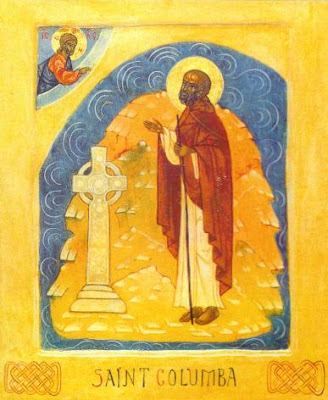ST. COLUMBA OF IONA (JUNE 9TH)
 |
| A Contemporary Icon of St. Columba of Iona |
Introduction
Today, we commemorate the life and legacy of St. Columba of Iona (AD 521 - AD 597), as one of the "12 Apostles of Ireland", who is one of the "Three Patrons Saints of the Celtic People", along with Sts. Patrick and Brigid. He is also remembered with Sts. Joseph of Arimathea, Alban, Aidan, Kentigern, Augustine, Dunstan, Theodore and Brendan as an influential saint in Ancient Great Britain and one of the founders of our Western Orthodox Patrimony.
Childhood and Young Life
St. Columba was born of Christian parents, descendent of the 5th Century Irish King, Niall of the Nine Hostages. He was baptized in the parish of Conwal, County Donegal, Ireland. His birth name was Crimthan, "little fox", but took the name Colmcille, or "Dove", either at priestly ordination or his later episcopal consecration. This name has subsequently been anglicized as "Columba." He became a monk at a young age, after studying Latin in one of the schools started by the disciples of St. Patrick. He was made a priest in his early twenties, and was known for his powerful preaching and his spiritual visions of angels at an early stage of his ministry. Many were healed by his prayers during his missionary journeys in Scotland, and the pagan Picts witnessed the power of the Sign of the Cross on multiple occasions, banishing the Loch Ness monster and opening the gates of a castle that were barred against his Christian witness.
 |
| St. Columba Opening the Gates with the Sign of the Cross |
St. Columba Banishes the Loch Ness Monster
“On another occasion also, when the blessed man was living for some days in the province of the Picts, he was obliged to cross the river Nesa (the Ness); and when he reached the bank of the river, he saw some of the inhabitants burying an unfortunate man, who, according to the account of those who were burying him, was a short time before seized, as he was swimming, and bitten most severely by a monster that lived in the water; his wretched body was, though too late, taken out with a hook, by those who came to his assistance in a boat. The blessed man, on hearing this, was so far from being dismayed, that he directed one of his companions to swim over and row across the coble that was moored at the farther bank. And Lugne Mocumin hearing the command of the excellent man, obeyed without the least delay, taking off all his clothes, except his tunic, and leaping into the water. But the monster, which, when it felt the water disturbed above by the man swimming, suddenly rushed out, and, giving an awful roar, darted after him, with its mouth wide open, as the man swam in the middle of the stream. Then the blessed man observing this, raised his holy hand, while all the rest, brethren as well as strangers, were stupefied with terror, and, invoking the name of God, formed the saving sign of the cross in the air, and commanded the ferocious monster, saying, "Thou shalt go no further, nor touch the man; go back with all speed." Then at the voice of the saint, the monster was terrified, and fled more quickly than if it had been pulled back with ropes, though it had just got so near to Lugne, as he swam, that there was not more than the length of a spear-staff between the man and the beast. Then the brethren seeing that the monster had gone back, and that their comrade Lugne returned to them in the boat safe and sound, were struck with admiration, and gave glory to God in the blessed man. And even the barbarous heathens, who were present, were forced by the greatness of this miracle, which they themselves had seen, to magnify the God! - The Life of St. Columba by Adamnan, Book 2, Ch. 28
The Importance of St. Columba
St. Columba was a monk, a bishop, a scholar and a fearless reformer of monasticism, revitalizing the Church and seeing the ultimate destruction of Druidism amongst the Celts. He worked to standardize Celtic Monasticism and root our heresies that had taken root amongst the decentralized and unaccountable clergy. He preached to the pagan Picts, converting them to Christ, and famously started monasteries in Ireland, Scotland, and on Iona. The community that he started on Iona is credited with preserving a propagating Celtic Christian art and monasticism up until the rise of the Viking Terror, which, in its dispersion, preserved European Christianity in an important and pivotal way. Because of St. Columba’s monks, much of the rest of Europe was Christianized!
St. Columba died on the 9th of June, AD 597, of natural causes, and was buried in the graveyard of his abbey on Iona. His relics were later removed in AD 849 and split between Scotland and Ireland. Some of his relics still rest with St. Patrick and St. Brigid at Saul Church near Downpatrick, Ireland.
The Prayer of St. Columba
High creator,
Ancient of Days,
and unbegotten,
who was without origin
at the beginning and foundation,
who was and shall be in infinite
ages of ages;
to whom was only begotten
Christ, and the Holy Ghost,
co-eternal in the everlasting
glory of Godhood.
We do not propose three gods,
but we speak of one God,
saving faith in three
most glorious Persons. Amen.
St. Columba, pray for us!
 |
| An Icon of St. Columba, Done in the Ancient Irish Style Typical of His Day |





Comments
Post a Comment